Brun Latrige - pocket pistol caliber 6 millimeters
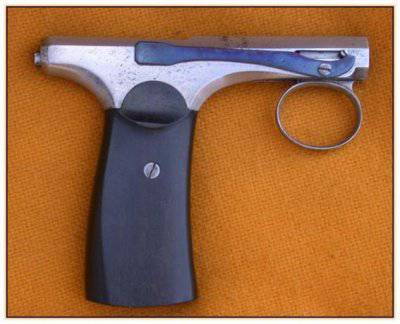 At the end of the nineteenth - early twentieth century, views on the question of ammunition for self-defense, and not only for self-defense, were somewhat different from modern ones. So, if you look closely at the models of weapons that were then positioned as a means of self-defense, then it should be noted that most of these models are the so-called “pocket” pistols. Indeed, this weapon was compact and lightweight and could easily be carried in a pocket without inconvenience. However, these kids also used appropriate ammunition that was clearly not the most successful for self-defense. So, if we take the most "weak" modern models of compact pistols, then they will most likely be fed with .25ACP cartridges and 5,6 annular ignition cartridges of millimeters and they are not recommended for use in self-defense, although they have a kinetic energy of a bullet at the muzzle slightly less than 100 Joule , then at the end of the nineteenth - early twentieth century, cartridges for self-defense weapons could be with the kinetic energy of a bullet even 5-10 Joules. For comparison, most air guns, which are sold simply upon presentation of a passport, have the kinetic energy of a lead pellet when fired up to an 3 Joule. In other words, the effectiveness of these pistols was very, very controversial, and the assured defeat of the enemy was only a successful coincidence of circumstances, and not the rule.
At the end of the nineteenth - early twentieth century, views on the question of ammunition for self-defense, and not only for self-defense, were somewhat different from modern ones. So, if you look closely at the models of weapons that were then positioned as a means of self-defense, then it should be noted that most of these models are the so-called “pocket” pistols. Indeed, this weapon was compact and lightweight and could easily be carried in a pocket without inconvenience. However, these kids also used appropriate ammunition that was clearly not the most successful for self-defense. So, if we take the most "weak" modern models of compact pistols, then they will most likely be fed with .25ACP cartridges and 5,6 annular ignition cartridges of millimeters and they are not recommended for use in self-defense, although they have a kinetic energy of a bullet at the muzzle slightly less than 100 Joule , then at the end of the nineteenth - early twentieth century, cartridges for self-defense weapons could be with the kinetic energy of a bullet even 5-10 Joules. For comparison, most air guns, which are sold simply upon presentation of a passport, have the kinetic energy of a lead pellet when fired up to an 3 Joule. In other words, the effectiveness of these pistols was very, very controversial, and the assured defeat of the enemy was only a successful coincidence of circumstances, and not the rule.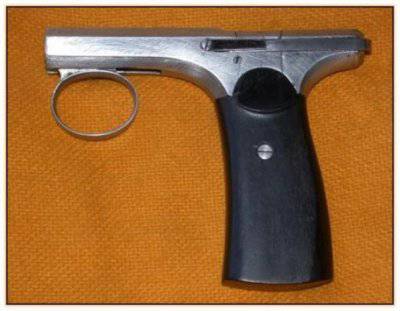 Despite the very low effectiveness of ammunition, such weapons are still of some interest. Even if you do not take into account the collection value of such samples, most of them are interesting from a technical point of view, since when such weapons were created, weapon canons that modern designers adhere to have not yet been formed. In other words, the gunsmiths of the time were not driven into frames, they had to invent their own solutions, which differed from modern ones in a great variety. So, a rather interesting version of pocket pistols of the late nineteenth - early twentieth century were non-automatic “expander” pistols. When clicking on the rear moving part of the frame or on another part, the cartridge was simultaneously fed, a platoon of spring and, as a result, a shot was fired. The simplest implementation of such pistols contributed to the relatively low price of such weapons, but it imposed a number of restrictions on the ammunition used, and the ease of handling was not at the highest place. One such gun was the French Brun Latrige pistol.
Despite the very low effectiveness of ammunition, such weapons are still of some interest. Even if you do not take into account the collection value of such samples, most of them are interesting from a technical point of view, since when such weapons were created, weapon canons that modern designers adhere to have not yet been formed. In other words, the gunsmiths of the time were not driven into frames, they had to invent their own solutions, which differed from modern ones in a great variety. So, a rather interesting version of pocket pistols of the late nineteenth - early twentieth century were non-automatic “expander” pistols. When clicking on the rear moving part of the frame or on another part, the cartridge was simultaneously fed, a platoon of spring and, as a result, a shot was fired. The simplest implementation of such pistols contributed to the relatively low price of such weapons, but it imposed a number of restrictions on the ammunition used, and the ease of handling was not at the highest place. One such gun was the French Brun Latrige pistol.Despite the complete difference between the design of weapons and modern models, he had a silhouette in which the gun was completely recognizable, and nothing else. This designer of the “pocket” weapon was developed by French designer Brune Latrige, who received a patent for his invention in 1896. On the one hand, the design of the weapon was really original, but if you dig a little among the old models of pistols, then you should not miss such a sample as Le Gaulois, and even before it there were less well-known samples. They were distinguished by the fact that the barrel was moving in Brun Latrige, while in Le Gaulois the shutter moved along with the rear part of the grip frame. However, all such guns were either based on one of the first patents of Latridge 1868 of the year, or were his weapon, so there is no one to blame for plagiarism. One can even say that Brune Latrige created a separate line of weapons from scratch, which, although it existed for less than half a century, still existed and even somehow developed, although there was, in principle, no room to develop with such a design.
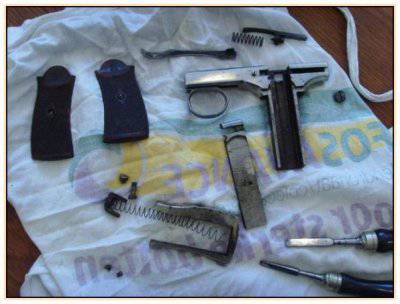 The simplicity or even to some extent the primitiveness of the Brun Latrige pistol allowed it to be made into a truly compact weapon. However, compactness was sufficiently conditional to preserve at least minimal ease of handling. So, the gun had a length equal to 125 millimeters, height 91,5 millimeters and width 25,5 millimeters, with weight in 324 gram. It was possible to create a more compact sample, but the design of the weapon provided for a very tight trigger ring, the pressure when pressed was more than 7 kgf, which even with such dimensions of the weapon was not very convenient. By the way, this is exactly what can be considered one of the main reasons for the widest distribution of a pistol. The fact is that, with its modest dimensions, it was not the most convenient for shooters with large and medium-sized hands, and for people with small sizes of hands, the force of pressing the trigger ring was excessive, although with fairly long training sessions the handling of the gun was simplified.
The simplicity or even to some extent the primitiveness of the Brun Latrige pistol allowed it to be made into a truly compact weapon. However, compactness was sufficiently conditional to preserve at least minimal ease of handling. So, the gun had a length equal to 125 millimeters, height 91,5 millimeters and width 25,5 millimeters, with weight in 324 gram. It was possible to create a more compact sample, but the design of the weapon provided for a very tight trigger ring, the pressure when pressed was more than 7 kgf, which even with such dimensions of the weapon was not very convenient. By the way, this is exactly what can be considered one of the main reasons for the widest distribution of a pistol. The fact is that, with its modest dimensions, it was not the most convenient for shooters with large and medium-sized hands, and for people with small sizes of hands, the force of pressing the trigger ring was excessive, although with fairly long training sessions the handling of the gun was simplified.The weapon is really simplified to the impossible, and does not have any devices protecting it from an accidental shot. The only thing that saves the gun from such a nuisance is the rather tight course of the trigger ring. It must be said that this is not enough to ensure the safety of the weapon, in the end, many revolvers have a similar pressing force when they are self-cocked, and so far no one has complained about them. But the advantages of the lack of safety devices more than enough. So, the most important of them is that the weapon is always ready for use, that for the means of self-defense is one of the most important parameters, even if it is not very effective. As well as the positive feature of the absence of any safety devices, it can be noted that the sides of the gun do not have switches and levers that could hinder the removal or carrying of weapons. The real thickness of the gun is less than 2 centimeters, it grew to 2,55 centimeters because of the handle of the weapon, which is made quite comfortable despite the modest dimensions of the gun. In addition, 10 cartridges are placed in the pistol grip, but you should not rejoice at the large amount of ammunition, since their effectiveness is very, very conventional.
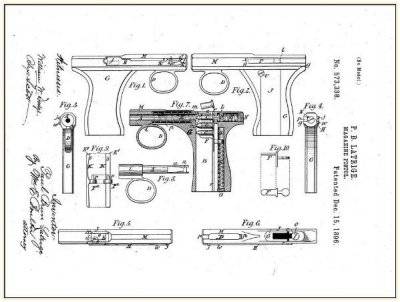 It feeds the weapon with cartridges specially designed for it with a caliber of 6 millimeters. Ammunition data was obtained by overturning the sleeve from the 8 mm cartridge for the Le Gaulois pistol. The gun bullet is bezobolochnaya, lead, has the weight of the entire 1,8 gram. The maximum speed that this bullet can reach is 150 meters per second, respectively, the maximum kinetic energy is slightly more than 20 Joules. Even despite the fact that the bullet is shellless, such ammunition cannot be called effective, well, in any way, especially if we recall Flaubert’s cartridges, which were originally originally intended for room shooting and shooting small rodents, and some of them are more powerful than this ammunition. Speaking in essence, effective self-defense with such weapons can only be in the case of firing into the groin area, knees (and it is quite difficult to get into fast moving legs even at a distance of five to ten meters), but it all depends on how low the pain threshold is the enemy and how seriously he is determined to harm the defender. In other words, such a weapon was then and now rather for reassuring its owner, who seemed to be armed, as it were, rather than specifically for successful use in the event of an attack.
It feeds the weapon with cartridges specially designed for it with a caliber of 6 millimeters. Ammunition data was obtained by overturning the sleeve from the 8 mm cartridge for the Le Gaulois pistol. The gun bullet is bezobolochnaya, lead, has the weight of the entire 1,8 gram. The maximum speed that this bullet can reach is 150 meters per second, respectively, the maximum kinetic energy is slightly more than 20 Joules. Even despite the fact that the bullet is shellless, such ammunition cannot be called effective, well, in any way, especially if we recall Flaubert’s cartridges, which were originally originally intended for room shooting and shooting small rodents, and some of them are more powerful than this ammunition. Speaking in essence, effective self-defense with such weapons can only be in the case of firing into the groin area, knees (and it is quite difficult to get into fast moving legs even at a distance of five to ten meters), but it all depends on how low the pain threshold is the enemy and how seriously he is determined to harm the defender. In other words, such a weapon was then and now rather for reassuring its owner, who seemed to be armed, as it were, rather than specifically for successful use in the event of an attack. The mechanisms of the gun worked as follows. The barrel of the weapon was spring-loaded and mobile, a ring rigidly connected to it was located under the cartridge chamber at the barrel. It was for this ring that the shooter pulled the barrel back in order to fire a shot. When moving the barrel back, he picked up a new cartridge and then cocked the mainspring. Having reached the extreme rear position, the barrel released the mainspring and a shot occurred. After this, the shooter released the trigger ring of the barrel, moved by the action of the return spring, and the cartridge case, being hooked to the ejector, was removed from the chamber and pushed out by the new cartridge from the magazine, which did not fly out with it due to the fact that length is longer than sleeve length.
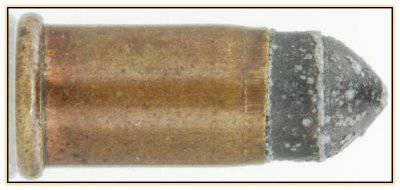 It would seem that such a weapon could well claim to be a pistol for entertaining firing, since it is clear that it is not suitable for self-defense, however, and with such use, the pistol proved to be not a very good model. The fact is that the accuracy of shooting from this weapon was not the best, the reason for this was the barrel of a pistol. With a completely normal length for a compact weapon in the 54 millimeter, it was not rifled, which apparently was done to reduce the cost of the weapon. But the barrel was not cylindrical, so it narrowed from 6,4 of a millimeter to 5,9 over the entire length, it was done more likely not to provide higher accuracy, but to create a higher pressure of powder gases in the barrel, respectively, a higher speed of the bullet from the barrel, however, with such a caliber and an unknown powder it is difficult to say something definite. In general, since the gun was primarily positioned as a means of self-defense, accuracy was enough for him at short distances to 5 meters.
It would seem that such a weapon could well claim to be a pistol for entertaining firing, since it is clear that it is not suitable for self-defense, however, and with such use, the pistol proved to be not a very good model. The fact is that the accuracy of shooting from this weapon was not the best, the reason for this was the barrel of a pistol. With a completely normal length for a compact weapon in the 54 millimeter, it was not rifled, which apparently was done to reduce the cost of the weapon. But the barrel was not cylindrical, so it narrowed from 6,4 of a millimeter to 5,9 over the entire length, it was done more likely not to provide higher accuracy, but to create a higher pressure of powder gases in the barrel, respectively, a higher speed of the bullet from the barrel, however, with such a caliber and an unknown powder it is difficult to say something definite. In general, since the gun was primarily positioned as a means of self-defense, accuracy was enough for him at short distances to 5 meters.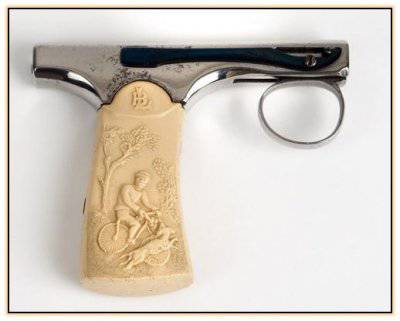 An interesting point was also the fact that in this model of weapons paid much attention to appearance. So, quite often it was possible to meet such pistols with a chrome-plated version, with artistic engraving, with a handle made of precious wood or ivory. In other words, despite its simplicity in manufacturing and low cost, the more expensive versions of these weapons also enjoyed success, which is somewhat confusing. If we talk about how much such weapons cost now, then even a simple pistol without artistic decoration can boast a five-digit price, naturally not in rubles, not to mention a weapon that was decorated in one way or another. The simple version of the weapon was really simple. So, it was made of ordinary steel, on which no coating was applied to protect it from corrosion. His grip was made of dark plastic, which was either absolutely smooth or had a small notch. Looking at the cheapest samples of this weapon, the impression does not disappear that it is before our eyes a handicraft made crossbow, and not a mass-produced model.
An interesting point was also the fact that in this model of weapons paid much attention to appearance. So, quite often it was possible to meet such pistols with a chrome-plated version, with artistic engraving, with a handle made of precious wood or ivory. In other words, despite its simplicity in manufacturing and low cost, the more expensive versions of these weapons also enjoyed success, which is somewhat confusing. If we talk about how much such weapons cost now, then even a simple pistol without artistic decoration can boast a five-digit price, naturally not in rubles, not to mention a weapon that was decorated in one way or another. The simple version of the weapon was really simple. So, it was made of ordinary steel, on which no coating was applied to protect it from corrosion. His grip was made of dark plastic, which was either absolutely smooth or had a small notch. Looking at the cheapest samples of this weapon, the impression does not disappear that it is before our eyes a handicraft made crossbow, and not a mass-produced model.The reasons are not the widest distribution of these weapons are visible, in full view. Not the most effective ammunition is clearly not promoted for the use of weapons in self-defense. It would seem that it would be possible to use weapons to shoot at rats in the basement, but the accuracy of the weapon was such that it would hardly have been possible to get at least one of them, which, incidentally, is indicated by the absence of any aiming devices. The simple design of the weapon also did not shine with special reliability. So, it was not uncommon to have a sticking cartridge case sticking when it was thrown out, which simply turned out to be stuck between the ejector and the new cartridge, although such failures were fairly easily fixed. The disadvantages can be attributed to the fact that the pistol was loaded with one cartridge through the window for ejection of cartridges, which partially covered the capacity of the weapon shop. A great effort of pressing the trigger ring also did not contribute to the proliferation of weapons, since, as a rule, a small hand does not have sufficient strength, and in a large palm the pistol not only looked funny, but was also very uncomfortable. In my personal opinion, these weapons are nothing but self-gunners made in the factory. Of course, it is possible to consider them to some extent as forerunners of shop-pistols, but by the time these guns appeared, there were already quite tolerable models that were close to modern models in their design. But still, such shooting expanders are interesting and unusual weapons, so knowing about it as part of stories development of firearms necessary.
- Karasik Kirill
- raigap.livejournal.com
Information